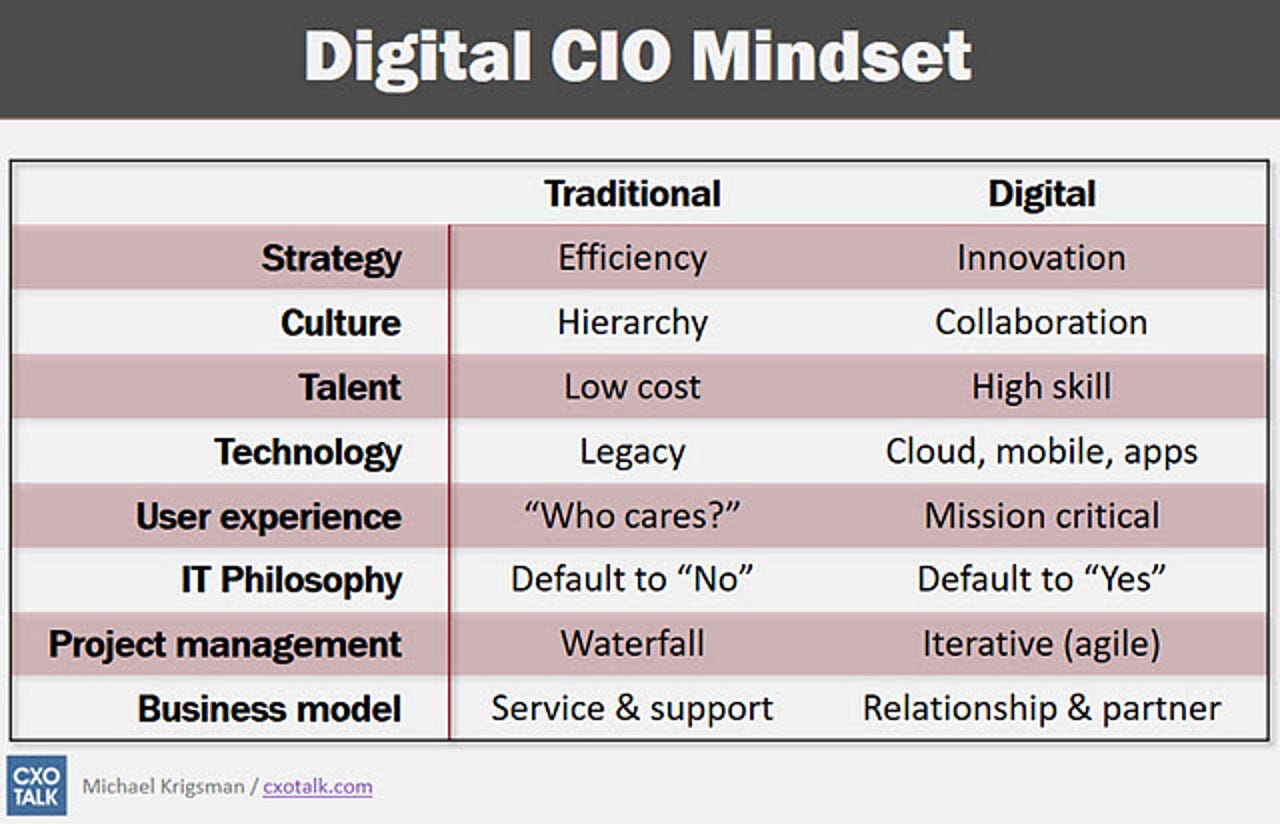Is 2016 (finally) the year of IT disruption?

We all know the business environment is changing rapidly, it's a cliché to say so. And yet, the impact of digital has had a profound influence on IT and the CIO. The massive popularity of the buzzword phrase digital transformation attests to this.
This impact is significant to the point where questions about CIO relevance and the long-term role of IT have become realistic and important. Regardless of the path IT evolution takes, it seems clear that infrastructure and innovation are the two pillars moving forward.
Infrastructure means the core: someone has to build and run the network, ERP, HCM, CRM, databases, and other backbone systems an organization needs to operate. It's all necessary but not necessarily sexy.
Innovation implies a stronger link to business strategy: finding ways to use technology in the service of growth, new business models, and better ways to shape the future.
Gartner and others talk about two-tier or bi-modal IT, reflecting the essential need for IT to address both sides of the operating model coin. Interesting thinker, Simon Wardley, criticizes this dual approach and explains some of the challenges, but the underlying need still remains.
In the context of this broad shift toward CIO as digital strategist, I read with interest 2016 CIO predictions from Oracle's Chief Communications Officer, Bob Evans. The predictions are important because Oracle occupies a unique and influential position in the market. Evans' view, therefore, encompasses learnings from across a range of Oracle customers.
Here is an edited summary of Evans' predictions, through which he offers advice to CIOs:
- Create New Revenue Streams. The digitization of our everyday lives opens up huge possibilities for IT-inspired innovation...
- Create a New Can-Do Culture. [T]he IT organization has permanently shed its "Dr. No" persona, with the initials "IT" now representing what the CIO's team really stands for: innovation/transformation.
- Create Dazzling--and Relevant--New Apps. World-class CIOs will find ways to transform their teams into engines of customer engagement, with app creation at the center.
- Evangelize the Business Benefits of Cloud Computing. Are you telling these stories clearly and passionately?
- Evangelize the Power of Digital Business. [T]the marriage of digital capabilities with traditional products and services opens up big possibilities for creating new value for customers.
- Transform Traditional Ideas/Silos of "What We Do." How can the CIO disrupt traditional thinking within her company by showcasing what already is, as well as what is possible?
- Transform Customer Engagement. What customers really want is often greatly at odds with what we as businesses are accustomed to--or comfortable--delivering. In 2016, CIOs must help lead the way in bridging this gap and driving customer-centric engagements.
- Transform Decision-Making from Gut-Level to Data-Driven. CIOs have a perfect opportunity to work with business leaders to unlock those data assets and put them to work in delivering real-world, real-time insights that create success for the business, for customers, and for employees.
- Accelerate the Reversal of the 80/20 Budget Trap via Cloud Computing. Before cloud computing, the #1 enemy of the CIO was the economic reality that about 80% of his IT budget would be consumed by low-value maintenance and integration. Because cloud computing pushes that burden over to cloud vendors, CIOs can liberate huge portions of their budgets and reallocate them to projects centered on growth and customer engagement.
- Accelerate Deployment of World-Class Cybersecurity. In the cloud, CIOs have the opportunity to flip that model from thousands of vulnerabilities to a single, unified, top-to-bottom cybersecurity stack where the cloud vendor shoulders that burden.
We can summarize the underlying pattern of these predictions in the phrase "Digital CIO Mindset."

Changing IT requires the CIO to combine a clear understanding of business goals with an agile approach to projects, ensuring that IT is staffed with modern technologists working together seamlessly with business people. It all seems obvious.
Yet, the goal is elusive because practical realities still include organizational silos, conflicting goals and expectations, and mismatched skill sets.
Consulting company Bain wrote about these issues in a recent report as did PwC in its 2016 research on Digital IQ.
At a high level, the goals are clear but getting there will remain fraught with difficulty during 2016.
Eventually, the imperative to change IT will become so obvious, compelling, and necessary that business leaders (including those in IT) will put aside fears and agendas to embrace real change. Only when that happens, will real disruption in IT occur. Call it the wisdom of no choice (with apologies to a book of similar name).
Perhaps acceptance of disruption will occur in 2016, but I doubt it. Maybe in 2017.
Disclosure: Oracle is a client.